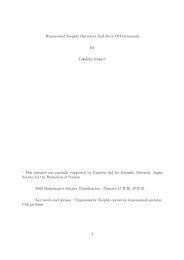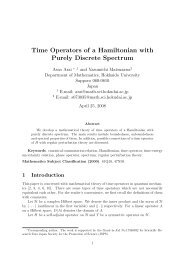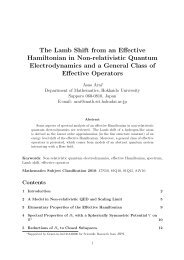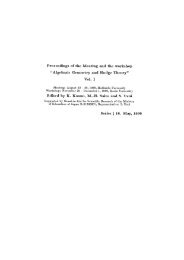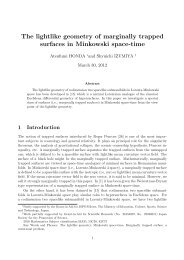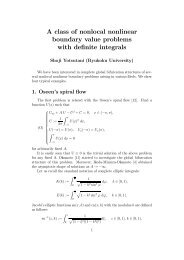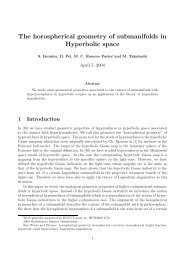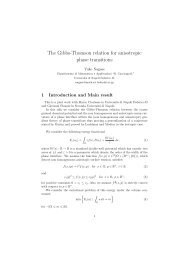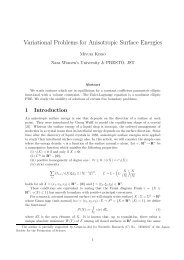Contact Geometry of second order I - Dept. Math, Hokkaido Univ ...
Contact Geometry of second order I - Dept. Math, Hokkaido Univ ...
Contact Geometry of second order I - Dept. Math, Hokkaido Univ ...
You also want an ePaper? Increase the reach of your titles
YUMPU automatically turns print PDFs into web optimized ePapers that Google loves.
oots α1,α3 and α4 in case <strong>of</strong> D4): Let (Jg, Cg) be the standard contact manifold <strong>of</strong> type<br />
(Xℓ, {αθ}). Then we have the double fibration;<br />
πg<br />
Rg<br />
⏐<br />
<br />
Mg<br />
πc<br />
−−−→ Jg<br />
Here (Xℓ, {αθ, αG}) is a graded Lie algebra <strong>of</strong> depth 5 and satisfies the following: dim ˇg−5 =<br />
dim ˇg−4 = 1, dim ˇg−3 = dim ˇg−2 = s and dim ˇg−1 = s + 1. In fact, comparing with the<br />
gradation <strong>of</strong> (Xℓ, {αG}), we have ˇ Φ + 5 = {θ}, ˇ Φ + 4 = {θ − αθ}, ˇ Φ + 3 = Φ + 2 , ˇ Φ + 2 consists <strong>of</strong><br />
roots θ − β for each β ∈ ˇ Φ + 3 and ˇ Φ + 1 consists <strong>of</strong> roots αθ and θ − αθ − β for each β ∈ ˇ Φ + 3 .<br />
Thus we see that ∂ (3) Eg = (πc) −1<br />
∗ (Cg), ∂ (2) Eg = (πg) −1<br />
∗ (∂Dg) and ∂Eg = (πg) −1<br />
∗ (Dg). We<br />
put D1 = ∂ (3) Eg and D2 = ∂Eg. Then (Rg; D1 , D2 ) is a P D manifold <strong>of</strong> <strong>second</strong> <strong>order</strong>. In<br />
fact, we have an isomorphism <strong>of</strong> (Rg; D1 , D2 ) onto (R(Mg); D1 Mg , D2 ) by the Realization<br />
Mg<br />
Lemma for (Rg, D1 , πg, Mg) and an embedding <strong>of</strong> Rg into L(Jg) by the Realization Lemma<br />
for (Rg, D2 , πc, Jg). Thus Rg is identified with a R-space orbit in L(Jg).<br />
) by utilizing the model P D mani-<br />
Now we will calculate the symbol <strong>of</strong> (R(X); D1 X , D2 X<br />
fold (Rg; D1 , D2 ) <strong>of</strong> <strong>second</strong> <strong>order</strong>, especially when (Xℓ, {αθ, αG}) is <strong>of</strong> BDℓ types. Let us<br />
describe the gradation <strong>of</strong> (BDℓ, {α1, α2, α3}) or (D4, {α1, α2, α3, α4}) in matrices form as<br />
follows: First we describe<br />
where<br />
o(k + 6) = {X ∈ gl (k + 6, K) | t XJ + JX = 0 },<br />
⎛<br />
0 0 0 0 0 0<br />
⎞<br />
1<br />
⎜0<br />
⎜<br />
⎜0<br />
⎜<br />
J = ⎜0<br />
⎜<br />
⎜0<br />
⎝<br />
0<br />
0<br />
0<br />
0<br />
0<br />
1<br />
0<br />
0<br />
0<br />
1<br />
0<br />
0<br />
0<br />
Ik<br />
0<br />
0<br />
0<br />
1<br />
0<br />
0<br />
0<br />
1<br />
0<br />
0<br />
0<br />
0<br />
0 ⎟<br />
0 ⎟<br />
0⎟<br />
∈ gl (k + 6, K),<br />
⎟<br />
0⎟<br />
0<br />
⎠<br />
Ik = (δij) ∈ gl (k, K).<br />
1 0 0 0 0 0 0<br />
Here Ik ∈ gl (k, K) is the unit matrix and the gradation is given again by subdividing<br />
matrices as follows;<br />
ˇg−5 =<br />
⎧ ⎛<br />
⎞⎫<br />
⎧ ⎛<br />
⎞⎫<br />
0 0 0 0 0 0 0<br />
0 0 0 0 0 0 0<br />
⎜0<br />
0 0 0 0 0 0⎟<br />
⎜ 0 0 0 0 0 0 0⎟<br />
⎪⎨<br />
⎜<br />
⎟<br />
⎜0<br />
0 0 0 0 0 0⎟⎪⎬<br />
⎪⎨<br />
⎜<br />
⎟<br />
⎜ 0 0 0 0 0 0 0⎟⎪⎬<br />
⎜<br />
⎟<br />
⎜<br />
⎟<br />
⎜0<br />
0 0 0 0 0 0⎟<br />
, ˇg−4 = ⎜ 0 0 0 0 0 0 0⎟<br />
, y, ξ0 ∈ K<br />
⎜<br />
⎟<br />
⎜<br />
⎟<br />
⎜0<br />
0 0 0 0 0 0⎟<br />
⎜ξ0<br />
0 0 0 0 0 0⎟<br />
⎝<br />
⎪⎩<br />
y 0 0 0 0 0 0<br />
⎠<br />
⎝<br />
⎪⎭ ⎪⎩<br />
0 0 0 0 0 0 0<br />
⎠<br />
⎪⎭<br />
0 −y 0 0 0 0 0<br />
0 0 −ξ0 0 0 0 0<br />
28



